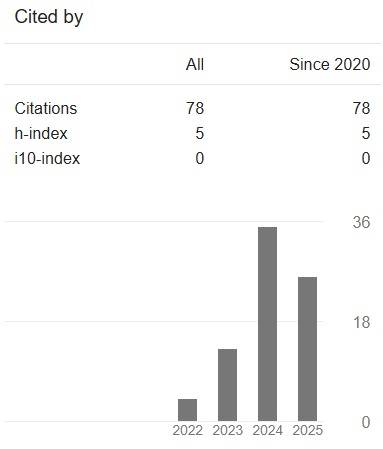The Investigation of Indoor Air Temperature Effects for Different Types of Window Dimensions Using CFD Simulation
DOI:
https://doi.org/10.24191/jaeds.v3i2.65Keywords:
Thermal comfort, Indoor air temperature, Window size, CFD simulationAbstract
Windows plays an important role in heat transfer and natural ventilation in buildings. In the field of building design, the challenge is to provide a thermally comfortable indoor environment that requires the least energy consumption to maintain. One of the energy reduction alternatives that can be incorporated into modern building design is the installation of efficient windows. The windows should allow thermally acceptable indoor air quality and have a pleasant design while being energy efficient. Good thermal conditions in school buildings, especially learning spaces, promote the educational process. Unfulfilling comfort levels can reduce the lecturers’ and students' physical and intellectual performance. One of the variables that affect the thermal comfort condition is indoor air temperature. The purpose of this study is to investigate the effect of window size on indoor air temperature by using Computational Fluid Dynamics (CFD) simulation. The selected classroom at Universiti Teknologi MARA (UiTM) Permatang Pauh, Pulau Pinang will be used as a case study. The field measurement result can be used to validate the simulation result. The simulation result will be compared to standard regulations set by the American Society of Heating, Refrigeration, and Air Conditioning Engineers (ASHRAE) Standard 55-2017. Three different sizes of windows have been chosen in this study which are double, triple, and quadruple-glazed windows. The validation result shows the percentage difference in indoor air temperature between the experimental and simulation is 1.04 %. The result found double and triple-glazed windows show the value of temperature under the range set by ASHRAE Standard 55-2017. The selection of triple-glazed windows is more suitable because the brightness of the classroom meets the criteria for the absence of direct solar radiation. In conclusion, the size of the window shows the performance in terms of heat transfer and indoor air temperature of the classroom.
Downloads
References
“Climate Change 2021: The Physical Science Basis,” Contribution of Working Group I to the Sixth Assessment Report of the Intergovernmental Panel on Climate Change, IPCC, Geneva, 2021.
S.M. Bambrook, A.B. Sproul and D.J. Bambrook, “Design optimization for a low energy home in Sydney,” Energy Build., vol. 43, no. 7, pp. 1702–1711, 2011.
F. Bre, A.S. Silva, E. Ghisi and V.D. Fachinotti, “Residential building design optimization using sensitivity analysis and genetic algorithm,” Energy Build., vol. 133, pp. 853–866, 2016.
W. Yang, N.H. Wong and C.Q. Li, "Effect of street design on outdoor thermal comfort in an urban street in Singapore," Journal of Urban Planning and Development, vol. 142, no. 1, p. 05015003, 2016.
R Ourghi, A. Al-Anzi and M. Krarti, "A simplified analysis method to predict the impact of shape on annual energy use for office buildings, " Energy Conversion and Management, vol. 48, no. 1, pp. 300-305, 2017.
M. Alwetaishi, “Impact of glazing to wall ratio in various climatic regions: a case study,” Journal of King Saud University-Engineering Sciences, vol. 31, no. 1, pp. 6-18, 2019.
D. Gomez-Mejia and B. Luis, “Optimisation of building shape and orientation for better energy efficient architecture,” J. Manag. Dev, vol. 23, no. 7, pp. 635-648, 2007.
S. Mirrahimi, M.F. Mohamed, L.C. Haw, N.L.N. Ibrahim, W.F.M. Yusoff and A. Aflaki, “The effect of building envelope on the thermal comfort and energy saving for high-rise buildings in hot–humid climate,” Renewable and Sustainable Energy Reviews, vol. 53, pp. 1508-1519, 2016.
S. Atthajariyakul and T. Leephakpreeda, “Real-time determination of optimal indoor-air condition for thermal comfort, air quality and efficient energy usage,” Energy and Buildings, vol. 36, no. 7, pp. 720-733, 2004.
E. Kuchen and M.N. Fisch, “Spot Monitoring: thermal comfort evaluation in 25 office buildings in winter,” Building and Environment, vol. 44, no. 4, pp. 839–847, 2009.
L. Chang, X. Zhang and Y. Cai, “Experimental determination of air inleakage to pressurized main control room caused by personnel entering,” Building and Environment, vol. 99, pp. 142–148, 2016.
N.A.M. Fohimi, K.M. Hyie, S.S.M. N. Hussin and F. Idrus, “Experimental Study of Indoor Air Temperature in the Laboratory,” Journal of Advanced Research in Experimental Fluid Mechanics and Heat Transfer, vol. 9, no. 1, pp. 1-8, 2022.
P.V. Nielsen, A. Restivo and J.H. Whitelaw, “The velocity characteristics of ventilated rooms,” Journal Fluid Engineering, vol. 100, no. 3, pp. 291–298, 1978.
Y. Cheng, J. Niu and N. Gao. “Thermal comfort models: A review and numerical investigation,” Building and environment, vol. 47, pp. 13-22, 2012.
R.F. Rupp, N.G. Vásquez and R. Lamberts, “A review of human thermal comfort in the built environment,” Energy and buildings, vol. 105, pp. 178-205, 2015.
Z. Wang, R. de Dear, M. Luo, B. Lin, Y. He, A. Ghahramani and Y. Zhu, “Individual difference in thermal comfort: A literature review,” Building and Environment, vol. 138, pp. 181-193, 2018.
D. Enescu, “A review of thermal comfort models and indicators for indoor environments,” Renewable and Sustainable Energy Reviews, vol. 79, pp. 1353-1379, 2017.
L.P. Xiang and H.Q. Wang, “Thermal comfort study based on airflow within a passenger compartment,” Applied Mechanics and Materials, vol. 730, pp. 109-112, 2015.
A.H. Poshtiri and S.M. Mohabbati, “Performance analysis of wind catcher integrated with shower cooling system to meet thermal comfort conditions in buildings,” Journal of Cleaner Production, vol. 148, pp. 452-466, 2017.
E. Enríquez, V. Fuertes, M. J. Cabrera, J. Seores, D. Muñoz, W. More and J.F. Fernández, “Model to evaluate the thermal comfort factor: Dynamic measurement of heat flow in building materials,” Journal of Building Engineering, vol. 20, pp. 344-352, 2018.
ASHRAE Standard 55, “Thermal Environmental Conditions for Human Occupancy,” 2017.
Downloads
Published
How to Cite
Issue
Section
License
Copyright (c) 2023 Siti Shareeda Mohd Nasir, Nor Azirah Mohd Fohimi, Norasikin Hussin, Rohidatun Mahmod@Wahab, Nurulsaidatulsyida Sulong

This work is licensed under a Creative Commons Attribution 4.0 International License.









